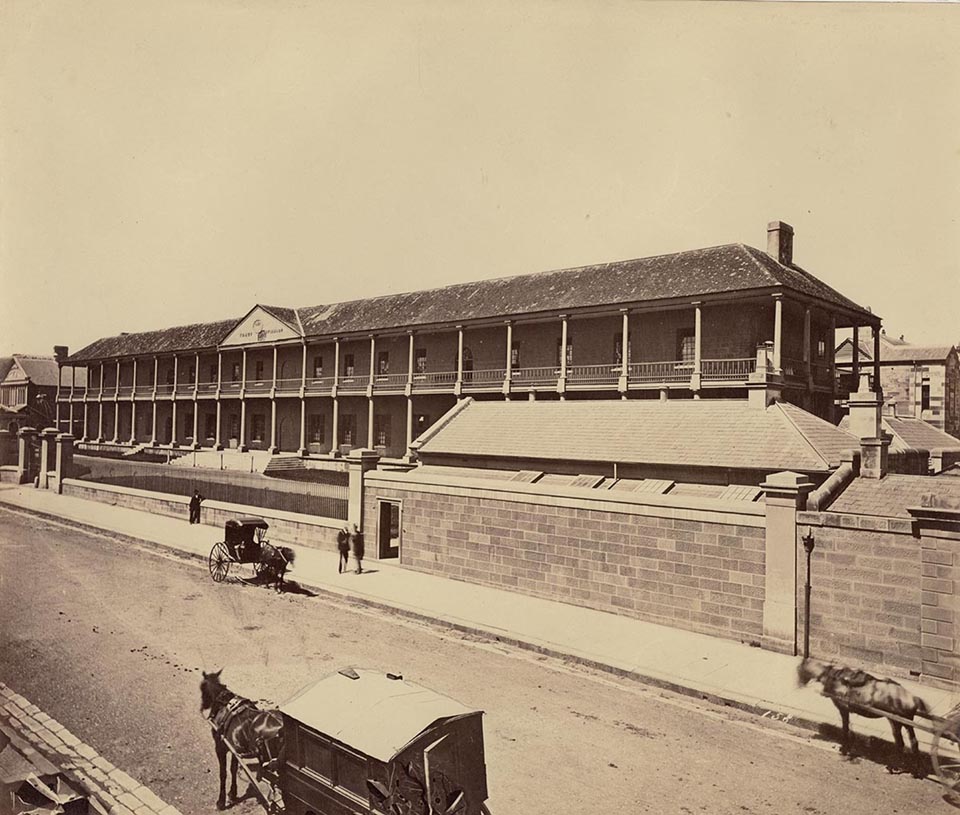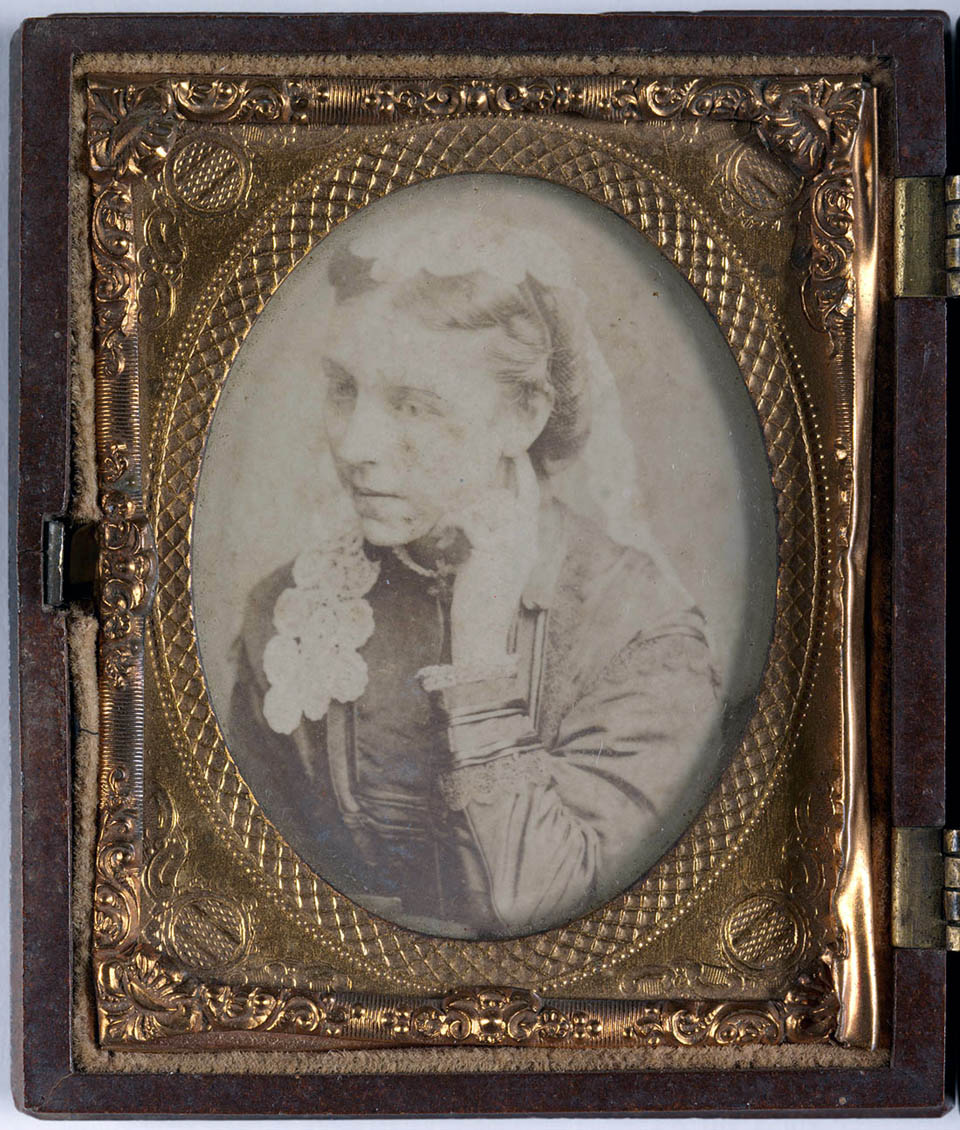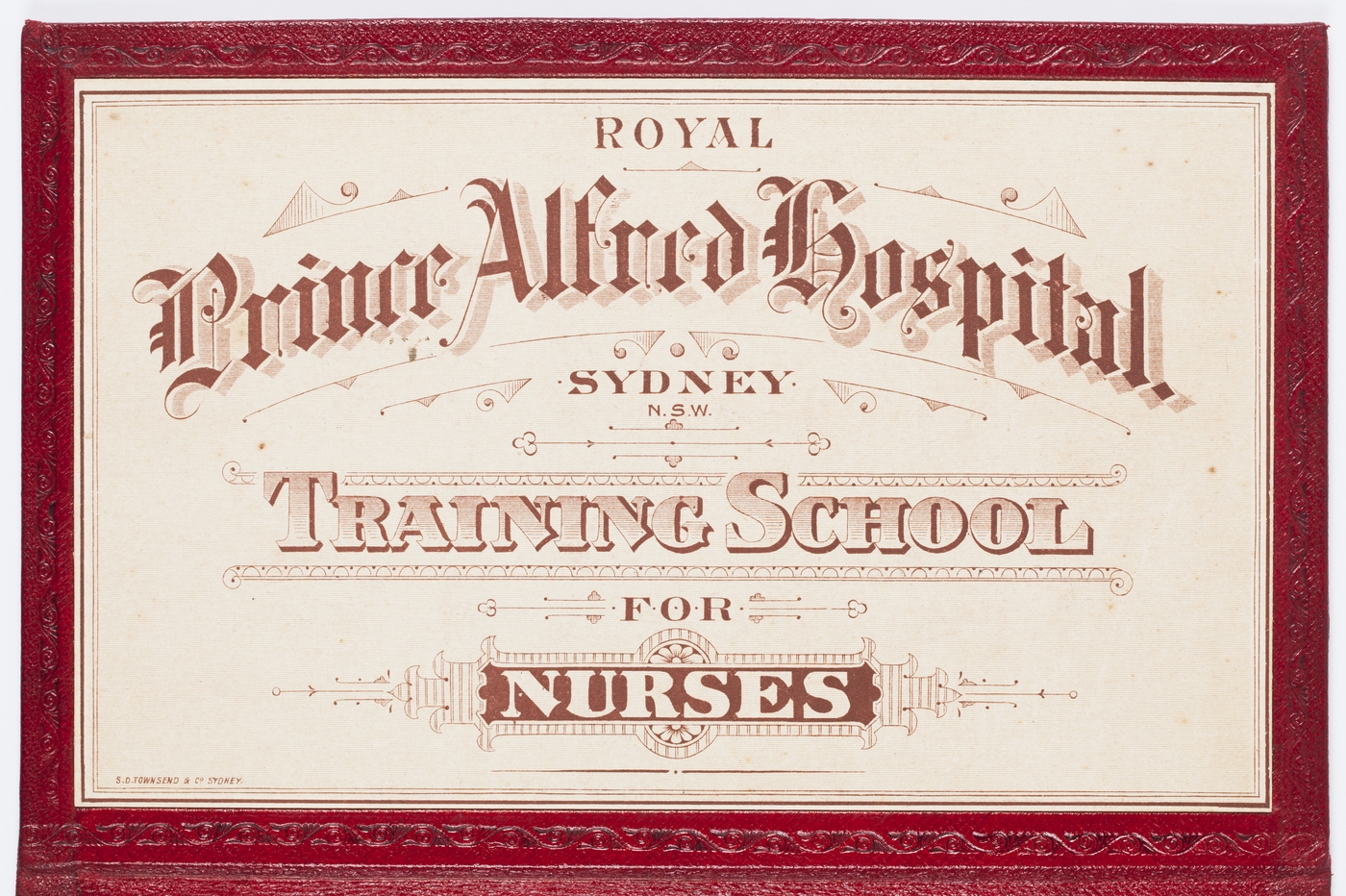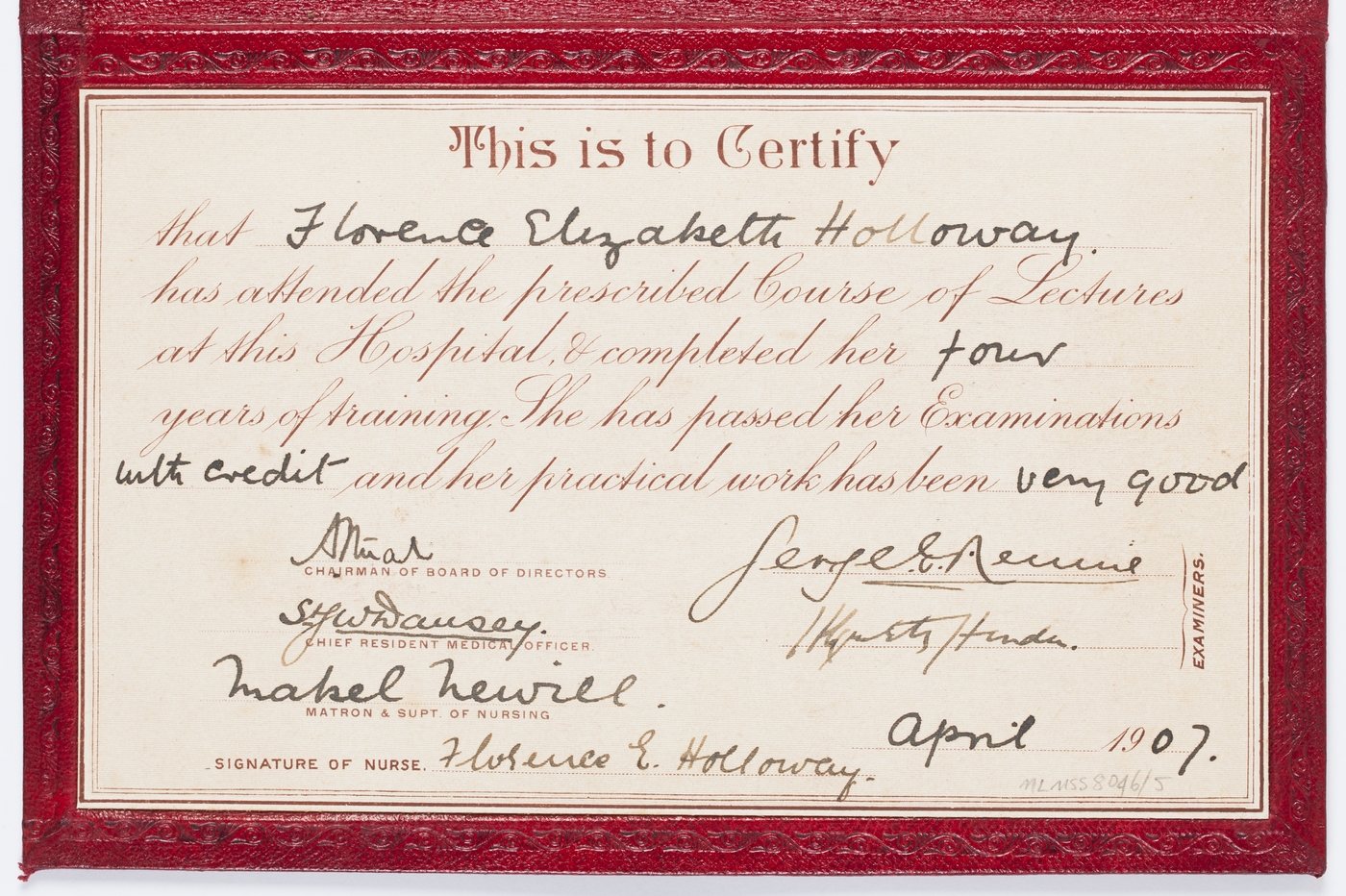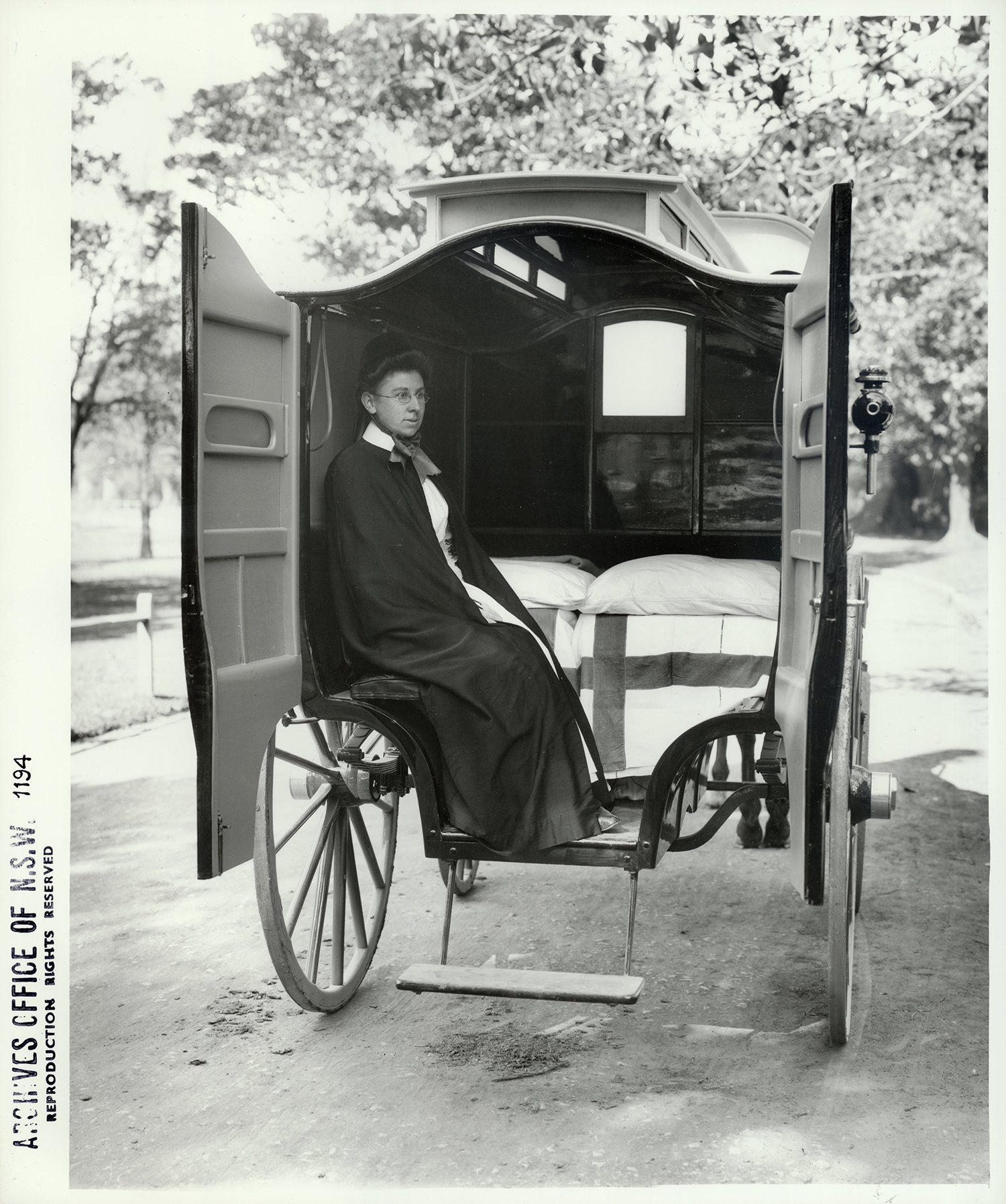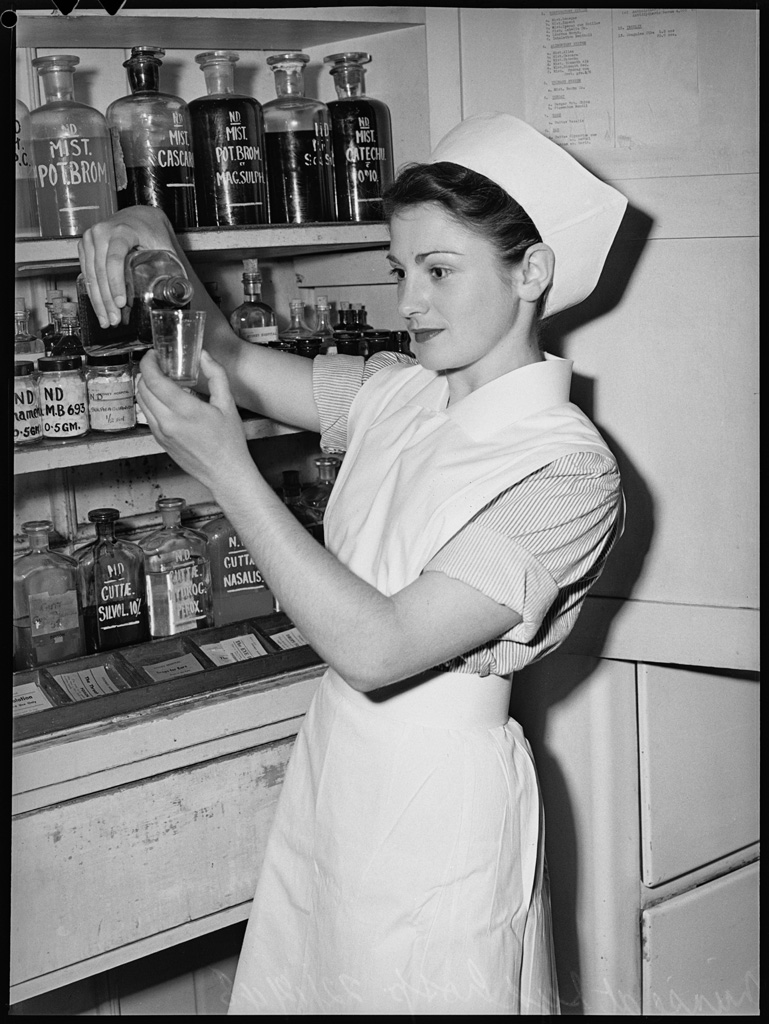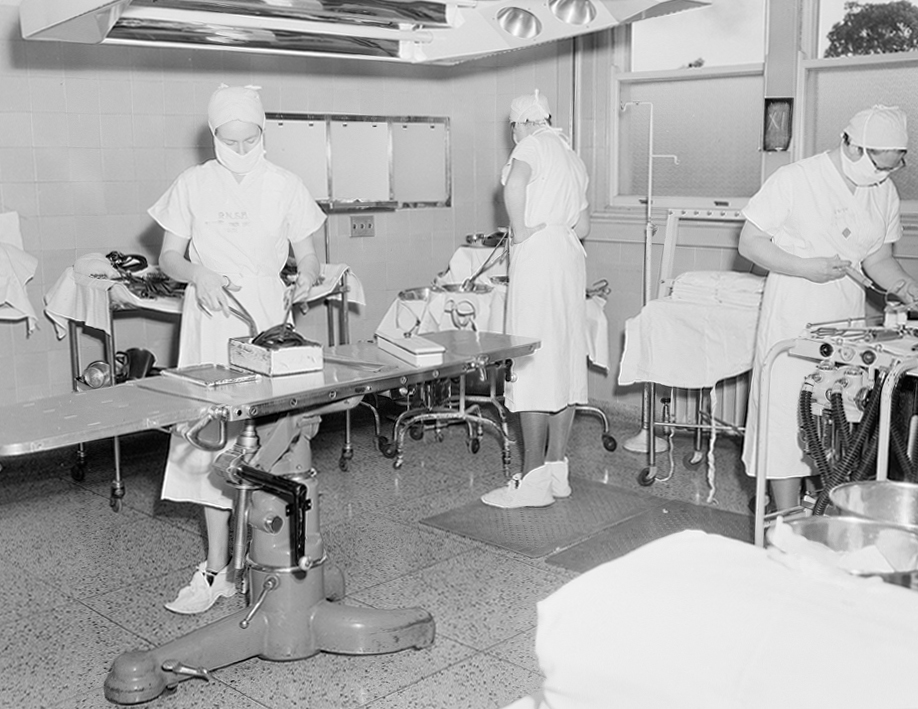The Dictionary of Sydney was archived in 2021.
Nursing
Citation
Persistent URL for this entry
To cite this entry in text
To cite this entry in a Wikipedia footnote citation
To cite this entry as a Wikipedia External link
Nursing
The concept of the 'nurse' has been shifting and ambiguous. Traditional societies, such as Sydney's pre-contact Aboriginal people, did not separate out the role of the nurse and relied instead on holistic healers. In European societies, as Florence Nightingale wrote in her famed Notes on Nursing, 'every woman is a nurse' as women mainly cared for sick family members. In the first decades of Sydney's European settlement, many listed as 'nurses' were actually midwives, or nursemaids employed to look after healthy young children. [1]
The focus of this entry is on hospital nursing, as nurses once trained in hospitals and it is where the majority of nurses work today. This is not to minimise the importance of home-based nursing, as before the early twentieth century all patients who could afford it were cared for by nurses who came to their homes. [media]In 1899 home nursing was extended to the poor with the founding of a charity, the Sydney Home Nursing Service. Home (or community) nursing has had a recent resurgence, particularly for the care of the chronically ill and aged patients. [2]
Sydney's first trained nurses
The first trained nurses in Sydney were the Sisters of Charity who arrived in 1838. They provided the sick with religious consolation, regular and conscientious attention, and also dispensed medicines. The Sisters' influence increased after they founded St Vincent's Hospital in 1857. Overall however, nursing sisterhoods had limited impact in Sydney. For most of the city's history its population was overwhelmingly Protestant, and the number of religious sisters has been comparatively small. [3]
Hospital nursing in Sydney was first undertaken in hospitals which were predominantly for convicts and the nurses were usually convalescent patients. The convention was that men nursed male patients and women nursed female patients. As most patients were male, the majority of nurses were also male. With the cessation of convict transportation, public hospitals catered for sick people who had no one to care for them at home, or who could not afford to hire private nurses. The main qualification for nurses was experience, generally gained through nursing sick family members, which meant that nurses tended to be older men and women. [4]
The need for trained nurses was recognised by Sydney doctors from the early 1860s, as it became clear that conscientious nursing was vital to the outcome of their improved medical and surgical practices. [media]One result was that the role of the matron expanded from that of an institutional housekeeper to also being responsible for the nursing. The most notable of these older-style matrons was the ex-convict Bathsheba Ghost, Matron of Sydney Infirmary (later Sydney Hospital) during 1852–66. [5]
Lucy Osburn and the Nightingale system
[media]Trained lay nurses made little impact on nursing in Sydney until 1868 when Lucy Osburn and five other nurses arrived to reform nursing at Sydney Hospital. They had been trained at the School of Nursing at St Thomas' Hospital in London, established in the name of the famed Florence Nightingale. They were employed by the colonial government and expected to establish Australia's first training school for nurses. In keeping with the Nightingale system of nursing, Osburn replaced the male nurses with female nurses. [6]
Their clinical skills were appreciated, but Lucy Osburn and her nurses also aroused intense opposition. Some doctors objected to Osburn's public assumption of authority, beginning a long tradition of medical yearning for nurses as doctors' 'handmaidens'. Three of her achievements merit particular note. First, she pioneered the employment of high status women ('ladies') in the public sphere and second, demonstrated the clinical necessity for trained, disciplined nurses. Thirdly, she supervised the training of approximately 153 nurses between 1868 and 1884. These nurses were the nucleus of the new occupation in Australia of secular, hospital-trained nurses. [7]
Nursing as a profession
[media]By 1899, doctors and patients had the problem of distinguishing between trained and untrained nurses. The solution was a voluntary register of trained nurses administered by the Sydney-based, Australasian Trained Nurses' Association. While doctors initially dominated the association, prominent Sydney nurses effectively used it to advance the status of nursing as a profession. Most notable of these Sydney nursing leaders was Susan McGahey, Matron of Royal Prince Alfred Hospital 1891–1904 and the second President of the International Council of Nurses. It was sadly typical that McGahey was feted overseas but frustrated in her attempts to initiate nursing reforms at home. [8]
[media]Sydney nurses have served in all the wars which involved Australia from the Boer War onwards. One indication of their enormous contribution is the war service of all Sydney Hospital matrons from 1891 to 1956. War service increased the high social esteem for nurses but also heightened military tendencies within nursing. In both world wars, untrained women in the Voluntary Aid Detachments also provided basic nursing care. [9]
[media]As the state increased its role in healthcare, governmental regulation of nursing also grew. In 1924, after long negotiations, the New South Wales government established the Nurses' Registration Board (NRB). It made the registration of trained nurses mandatory and treated midwifery as a nursing speciality, a situation only reversed in 2004. Today the Nurses and Midwives Board is 'responsible for the registration of nurses and midwives, the authorisation of nurse practitioners and midwife practitioners, and the enrolment of nurses in New South Wales'. While medical practitioners once dominated, the board now includes nurses, midwives, a lawyer and community representatives. [10]
[media]Nurses gained enormous social respect through adapting the religious concept of a 'vocation' so that nursing became an expression of an innate need to care for the sick. Contrary to the myth that nurses have always been underpaid, for the first half of the nineteenth century nursing was a 'relatively well-paid female occupation'. The problem was that it was physically demanding and the hours were long. With few alternative occupations and strong disincentives to move from one hospital to another, nurses were reluctant to protest. They resisted, for example, moves to include them in the Australian ideal of an eight-hour working day. Nurses' working conditions were additionally stressful because trainees undertook the majority of the nursing. Senior nurses responded to this potentially dangerous situation by relying on rigid discipline, automatic obedience and the terror of instant dismissal. While many senior nurses were kind, by 1908 the 'battleaxe' nurse was a recognisable stereotype. [11]
Changes to nursing
During the 1930s Depression hospital budgets were severely cut, the ratio of trainees to registered nurses rose and nurses' working conditions deteriorated. Living in a Nurses' Home was compulsory and conditions in these institutions also worsened. Many matrons had a relatively privileged lifestyle and identified with the financial interests of their hospitals. In 1933, at the height of the Depression, the Matron of Royal Prince Alfred Hospital insisted to the Industrial Commission that it was no strain for nurses to have a working week of 52½ hours, and sisters 48 hours. [12]
More radical nurses helped to form their own nurses' union, the New South Wales Nurses' Association, in 1931. The union's formation was spurred on by the threat of compulsory unionism and the support of noted Sydney feminist Jessie Street. It became a powerful advocate for nurses and is today based in Camperdown. [13]
[media]While nurse shortages were a recurring problem, from the 1940s the shortage became severe, worldwide and entrenched. Two key reasons for the shortage were declining working conditions and an inexorable rise in the demand for nurses. The shortage gradually affected even the most prestigious Sydney hospitals which had previously maintained waiting lists of applicants. By the 1960s nurses in understaffed hospitals struggled to provide adequate patient care. [14]
Changes to improve recruitment and retention were gradually introduced. The rigid nursing discipline on and off duty was relaxed. Nurses abandoned their starched uniforms for more functional, comfortable clothing. Sydney hospitals accepted and trained nurses' aides (now called enrolled nurses) to undertake supervised basic care. Married women were allowed to train and nurse, and part-time employment was permitted. Men were reintroduced into general nursing rather than restricted to psychiatric nursing. One indirect effect of this was the demise of gender-specific titles such as 'Sister'. Another sign of change was that Indigenous applicants were admitted into registered nursing programs. During the 1980s Sydney hospitals also opened child care centres, largely to attract mothers back to nursing. [15]
In this postwar period, nursing dramatically changed. Technology became more sophisticated and nursing practice more holistic. Hospital patients tended to be more acutely ill and discharged more rapidly. The introduction of disposable equipment from the 1950s meant that trainee nurses no longer spent hours cleaning equipment. The differences between private and public patients, with trainees tending to nurse the latter, declined as adequate hospital care became accepted as a right for all. Patients also demanded more privacy than was allowed by the long 'Nightingale wards' which had made supervising student nurses comparatively easy. Patients, and nurses, began to question rather than trustingly submit. Nurses also began to object to their relative powerlessness within hospitals, which had resulted in their tending to be blamed for any adverse outcomes concerning patients. [16]
The need for further, specialised education for registered nurses was also recognised. [media]Nurses established the New South Wales College of Nursing in 1949 to provide post-registration nursing courses. Today it is situated at Burwood and continues to provide post-registration courses and professional leadership. [17]
Professional education
A unique problem for nursing has been an underlying conviction that formal education away from patients is detrimental to good nursing. This belief, and medical opposition, contributed to Lucy Osburn abandoning her efforts at formal training by 1873. It flared up again in the opposition to Preliminary Training Schools (PTS). The first PTS in Sydney was established at Royal Prince Alfred Hospital in 1936, some 40 years after the first such school was founded in Britain. It gave new nurses introductory lessons for six to eight weeks before they began duty in the wards. Even by the mid-1950s many smaller Sydney training hospitals still did not have a PTS. Similarly, the introduction of the 'block system' from the 1950s was also delayed due to opposition. The block system set aside blocks of weeks for nurses' formal education. During these blocks they did not have to work on the wards. [18]
[media]By the 1980s nursing had been bombarded with numerous expert reports identifying serious deficiencies in nursing training. The obstacles to change were summarised by St Vincent's Hospital as 'manpower and finances', that is, a constantly renewable source of trainee nurses provided the bulk of the hospital care for minimal cost. After some experimental programs, the New South Wales government decided to phase out hospital training. That decision was inevitable once it was found that hospital training had become more expensive than nursing education in tertiary institutions. The increased cost was partly the result of the change to broad-based general registration preceding specialisation in, for example, mental health nursing. In 1985 pre-registration nursing courses were transferred from hospitals to colleges of advanced education. New South Wales became one of the first places in the world where all pre-registration nursing courses were provided by tertiary institutions. For many Sydney nurses it was a 'long cherished dream'; others bitterly opposed it as 'bloody murderous'. In 2007, Sydney nurses took to the streets to successfully oppose a return to hospital-based training. [19]
A period of painful adjustment took place as hospitals adapted to having student nurses on clinical placements, rather than relying on them providing ongoing basic patient care. A further shock came in 1990 when colleges of advanced education in New South Wales were absorbed into universities. An inadvertent result was that all pre-registration nursing education was upgraded to university level. This move promoted long-needed research into nursing practice. Four Sydney universities now offer nursing programs from pre-registration to doctoral level. [20]
Sydney's nurses today
One constant struggle for nurses in Sydney, as elsewhere, has been their exclusion from decisions which vitally affect them. One example is the 1988 decision to relocate the Royal Alexandra Children's Hospital to Westmead. Recognition of the need for consultation was partly met by the employment of nurses within the New South Wales Department of Health. This need was further acknowledged in 1990 with the appointment of a Chief Nursing Officer who is based at North Sydney and reports directly to the New South Wales Minister of Health. [21]
Today registered nurses qualify by completing a three-year university degree. They also supervise the basic patient care provided by assistants in nursing and enrolled nurses, both of whom qualify through Technical and Further Education (TAFE) college courses. Registered nurses can then choose from a large number of nursing specialities. A more recent development is the qualified nurse practitioner who engages in more autonomous advanced practice. The Nightingale legacy still ensures that around 90 per cent of nurses are female. Nursing continues to be a major source of employment with the four greater Sydney area health services employing nearly 32,000 registered and enrolled nurses.
The final word on nursing comes from the Morgan Poll. Nursing in Australia – and Sydney is unlikely to be an exception – has been perceived as the most honest and ethical profession since first included in the survey in 1994. [22]
Notes
[1] Florence Nightingale, Notes on Nursing: What it is and What it is Not, Dover Publications, Toronto, 1969, p 3
[2] Mary Sparke, Going the Extra Mile: A Pictorial History of the Sydney Home Nursing Service 1900–2000, Northern Sydney Health, Sydney, 2000
[3] Siobhan Nelson, Say Little, Do Much: Nursing, Nuns, and Hospitals in the Nineteenth Century, University of Pennsylvania Press, Philadelphia, 2001, ch 5
[4] Angela Cushing, 'Convicts and Care Giving in Colonial Australia' in AM Rafferty, J Robinson and R Elkan (eds), Nursing History and the Politics of Welfare, Routledge, London, pp 108–32; Judith Godden, Lucy Osburn, a Lady Displaced: Florence Nightingale's Envoy to Australia, Sydney University Press, Sydney, 2006, p 102
[5] Judith Godden, 'Bathsheba Ghost, Matron of the Sydney Infirmary 1852–66: A Silenced Life', Labour History, no 87, November 2004, pp 49–63
[6] Judith Godden, Lucy Osburn, a Lady Displaced: Florence Nightingale's Envoy to Australia, Sydney University Press, Sydney, 2006
[7] Judith Godden, Lucy Osburn, a Lady Displaced: Florence Nightingale's Envoy to Australia, Sydney University Press, Sydney, 2006; Judith Godden, 'Matching the Ideal? The First Generation of Nightingale Nursing Probationers, Sydney Hospital, 1868–84', Health and History, 2003; Judith Godden, '"Be good sweet maid": Sister Probationer Nora Barton at the Sydney Infirmary, 1869–72', Labour History, no 80, 2001, pp 141–56; Rosalind Gillespie, Handmaidens And Battleaxes, video recording, Ronin Films, Canberra, 1990
[8] Judith Godden and Susan Forsyth, 'Defining Relationships and limiting power: Two leaders of Australian nursing, 1868–1904', Nursing Inquiry, vol 7, no 1, 2000, pp 10–19
[9] Jan Bassett, Guns and Brooches: Australian Army Nursing from the Boer War to the Gulf War, Oxford University Press, Melbourne, 1992; Melanie Oppenheimer, All Work No Pay: Australian Civilian Volunteers in War, Ohio Productions, Walcha NSW, 2002
[10] Glenda Law, '"I Have Never Liked Trade Unionism": the Development of the Royal Australian Nursing Federation, Queensland Branch, 1904–45' in E Windschuttle (ed), Women, Class and History: Feminist Perspectives on Australia 1788–1978, Fontana, Collins, Sydney, 1980, pp 192–215; Nurses Registration Board, History of the New South Wales Nurses Registration Board, the board, Sydney, 1990, viewed December 2007, http://www.nmb.nsw.gov.au/default.aspx; Margaret Adamson, '"A Hardy Annual": the Question of the State Registration of Nurses in New South Wales, 1899–1924', BA honours thesis, Macquarie University, Sydney, 1986
[11] Josephine Castle, 'The Development of Professional Nursing in New South Wales, Australia', in C Maggs (ed), Nursing History: The State of the Art, Croom Helm, London, 1987, p 9; Sydney Morning Herald, 25 November 1910, p 8; Cartoon by H Souter, Lone Hand, 1908, reproduced in Beverley Kingston, My Wife, My Daughter and Poor Mary Ann: Women and Work in Australia, Nelson, Melbourne, 1975, p 97
[12] Sydney Morning Herald, 29 June 1933, p 9
[13] Judith Godden, 'No-one can take away the kudos? Jessie Street and the unionisation of nurses in New South Wales', in H Radi (ed), Jessie Street: Documents and Essays, Women's Redress Press, Sydney, 1990, pp 94–103; Mary Dickenson, An Unsentimental Union: The New South Wales Nurses Association 1931–1992, Hale & Iremonger, Sydney, 1993
[14] Lynette Russell, From Nightingale to Now: Nurse Education in Australia, Harcourt Brace Jovanovich, Sydney, 1990
[15] Dorothy Raxworthy, 'The Changing Face of Nursing: Nurse Training in Sydney 1935–1985', in J Shields (ed), All Our Labours. Oral Histories of Working Life in Twentieth Century Sydney, University of New South Wales Press, Sydney, 1992, pp 144–69; Telegraph Mirror, 24 December 1990; Daily Telegraph, 7 September 1987
[16] Nursing Times, 22 May 1985, p 33; Sydney Morning Herald, 25 November 1989
[17] Rosalie Pratt and Lynette Russell, A Voice to be heard, The first fifty years of the New South Wales College of Nursing, Allen & Unwin, Sydney, 2002
[18] Judith Godden, Lucy Osburn, a Lady Displaced: Florence Nightingale's Envoy to Australia, Sydney University Press, Sydney, 2006, pp 225–26; Lynette Russell, From Nightingale to Now: Nurse Education in Australia, Harcourt Brace Jovanovich, Sydney, 1990, pp 70–71, 100, 118, 145; Muriel Doherty, edited by L Russell, Off the Record – The Life and Times of Muriel Knox Doherty 1896–1988, New South Wales College of Nursing, Sydney, 1996; Dorothy Raxworthy, 'The Changing Face of Nursing: Nurse Training in Sydney 1935–1985', in J Shields (ed), All Our Labours. Oral Histories of Working Life in Twentieth Century Sydney, New South Wales University Press, Sydney, 1992, p 150
[19] 'Nurses Need Time to Study', The Sun, 16 May 1956; Lynette Russell, From Nightingale to Now: Nurse Education in Australia, Harcourt Brace Jovanovich, Sydney, 1990; Lynette Russell, 'Nursing education: a time for change 1960–80', The Australian Journal of Advanced Nursing, vol 5 no 4, June–August 1988, pp 36–44; Margaret Rosenthal and Judith Godden, 'The Institute of Nursing Studies', in M Koder, (ed), In Transit: Sydney CAE 1982–1989, Sydney College of Advanced Education, Sydney, 1988, pp 179–93; Graeme Head, Sun-Herald 1984; 'Letters to Editor', Sydney Morning Herald, 17 November 1983, 12 December 1983, 16–18 December 1985; The Australian 18 December 1985; 'Editorial', The Australian, 21 December 1985; John Howard, Press Release: Australian Hospital Nursing Schools, Commonwealth Government, Canberra 14 September 2007
[20] Daily Telegraph, 11 July 1989; Sydney Morning Herald, 1 November 1989; Margaret Rosenthal and Judith Godden, 'The Institute of Nursing Studies', in M Koder (ed), In Transit: Sydney CAE 1982–1989, Sydney College of Advanced Education, Sydney, 1988
[21] Sandra Moait, 'Relocation of Teaching Hospitals', The Lamp, October 1988, pp 8–9; New South Wales Department of Health, 'Nursing and Midwifery Office', NSW Department of Health, Sydney, viewed December 2007
[22] 'Nurses, Pharmacists And Doctors Most Respected Professions, Car Salesmen, Journalists And Real Estate Agents Least Respected', Finding No. 3349, The Bulletin, 9 November 2000, accessed December 2007, http://www.roymorgan.com/news/polls/2000/3349/
.



